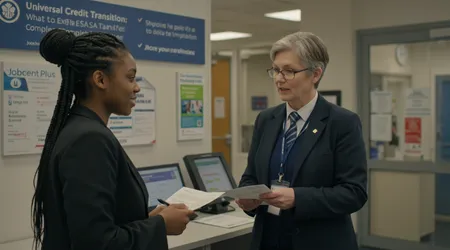Universal Credit Transition: What to Expect as ESA Transfer Completes

The universal credit transition is reshaping the UK’s welfare landscape, with the Department for Work and Pensions (DWP) targeting completion by March 2026.
For those on income-related Employment and Support Allowance (ESA), this shift marks a pivotal moment.
The process, known as managed migration, is complex, emotive, and demands clarity. This article unpacks what claimants can expect, blending practical insights with real-time updates.
From migration notices to financial implications, we’ll guide you through the maze. Why does this matter? Because your financial stability hinges on understanding this change.
The universal credit transition isn’t just bureaucratic reshuffling; it’s a structural overhaul of how benefits are delivered.
Legacy benefits like ESA, Tax Credits, and Housing Benefit are being phased out. The DWP’s goal is a streamlined system, but the journey is fraught with challenges.
Vulnerable claimants, especially those with health conditions, face uncertainty. With migration notices landing on doorsteps, the clock is ticking.
This piece draws on current data, real-world examples, and expert insights to demystify the process, ensuring you’re prepared for what lies ahead.
Understanding the Universal Credit Transition
The universal credit transition replaces fragmented legacy benefits with a single payment.
Income-related ESA claimants are the final group to migrate, with notices issued by September 2025.
The DWP sends migration notices, giving claimants three months to apply for Universal Credit (UC). Miss the deadline, and payments stop.
Over 200,000 ESA claimants have already transitioned, showing progress but highlighting scale.
This shift isn’t a simple swap. UC operates on a monthly payment cycle, unlike ESA’s fortnightly schedule. Claimants must adjust budgeting habits.
For example, Sarah, a 45-year-old with chronic fatigue, struggled with UC’s five-week wait for the first payment.
Her ESA “run-on” payments bridged the gap, but unexpected bills still hit hard. Preparation is key.
++ 30 Hours Free Childcare: Who Qualifies from September 2025?
The universal credit transition also introduces digital management. Claimants must use an online UC journal to report changes.
For those less tech-savvy, like pensioner John, this feels daunting. Local Jobcentres and the DWP’s Help-to-Claim scheme offer support, with £15 million allocated to ease ESA transitions.
Navigating this digital shift requires proactive engagement.

Financial Implications of the Transition
The universal credit transition brings mixed financial outcomes. The DWP claims 55% of claimants will be better off, 35% worse, and 10% unchanged.
If worse off, transitional protection payments cover shortfalls, but only for managed migration claimants. Applying early risks losing this safety net, as Shelter England warns.
| Benefit | Legacy Payment Frequency | UC Payment Frequency | Transitional Protection |
|---|---|---|---|
| Income-related ESA | Fortnightly | Monthly | Yes, if migrated by DWP |
| Housing Benefit | Fortnightly/Monthly | Monthly | Yes, if migrated by DWP |
| Tax Credits | Weekly/Fortnightly | Monthly | Ended April 2025 |
For vulnerable claimants, deductions pose risks. From April 2025, UC deductions for debts are capped at 15% of the standard allowance, down from 25%.
This helps, but budgeting advances interest-free loans still reduce monthly payments. Claimants must plan carefully to avoid debt spirals.
Also read: Social Benefits Reform in the UK: Impact on Cost of Living
Consider Lisa, a single parent with mobility issues. Her UC payment was lower than her ESA due to misreported health conditions.
After appealing, she secured the Limited Capability for Work and Work-Related Activity (LCWRA) element, boosting her income.
Read more: Cultural Events Bring Life to the UK in May
This underscores the need to double-check UC assessments. Accuracy in reporting health conditions can make or break financial stability.
Challenges for Vulnerable Claimants
The universal credit transition disproportionately affects those with health conditions.
ESA claimants in the support group, like those with severe disabilities, should transfer to UC’s LCWRA group without reassessment.
Yet, errors occur. Posts on X highlight fears of losing severe disability premiums, a concern for many.
Mental and physical health barriers complicate the process. The DWP offers extra support, but claimants must request it.
For instance, Mark, a 50-year-old with depression, missed his migration notice deadline due to anxiety.
His payments stopped, forcing him to reapply as a new claimant without transitional protection. Early communication with the DWP is critical.
Digital exclusion is another hurdle. The UC system assumes online access, but not all claimants have reliable internet.
Libraries and Jobcentres provide alternatives, but these require effort. The universal credit transition demands proactive steps, yet vulnerability can hinder action.
Claimants must leverage support networks to stay afloat.
Practical Steps to Prepare for the Transition
Preparation is the cornerstone of a smooth universal credit transition. Start by checking your migration notice carefully.
It outlines your deadline typically three months from receipt. Set reminders to avoid missing it. Use the DWP’s helpline (0800 328 5644) for clarification. Don’t delay; time is unforgiving.
Next, gather documents: bank details, proof of identity, and health records. These ensure accurate UC applications.
For example, Jane, a 38-year-old with arthritis, submitted detailed medical evidence upfront, securing LCWRA status swiftly.
In contrast, vague submissions can delay or reduce payments. Precision matters.
Budget for the five-week wait. ESA payments continue for two weeks post-claim, but the gap can sting. Explore budgeting advances or local welfare assistance.
Finally, use benefits calculators from Policy in Practice or Turn2Us to estimate UC entitlement. Knowledge empowers you to navigate this shift confidently.
Engage with support services early. Citizens Advice and the DWP’s Help-to-Claim initiative guide claimants through applications.
Don’t assume the system will catch errors double-check everything.
The universal credit transition is like crossing a river: one misstep can sweep you downstream, but preparation builds a sturdy bridge.
Policy Context and Future Outlook

The universal credit transition reflects broader welfare reforms. The Spring Budget 2025 raised the UC standard allowance to £98 weekly for singles over 25 by 2026, above inflation.
However, cuts to the health element for new claimants slashed by 50% sparked backlash. This risks undermining support for disabled claimants.
By 2028, New Style ESA and Jobseeker’s Allowance will merge into Unemployment Insurance, a time-limited benefit.
This signals ongoing change, with work-focused policies gaining traction. For ESA claimants, the current migration is just one chapter in a shifting narrative. Staying informed is non-negotiable.
Public sentiment, reflected on X, shows anxiety. Posts warn of reduced payments and bureaucratic errors, especially for those with complex needs.
The DWP’s £1 billion investment in work support aims to counter this, but trust remains fragile. Claimants must advocate for themselves to secure their entitlements.
Navigating the Emotional Toll
Transitioning to UC isn’t just logistical it’s emotional. The uncertainty of changing systems can feel like standing on shifting sand.
Claimants report stress, particularly those with mental health conditions. The DWP’s support mechanisms, like phone lines, often face delays, heightening anxiety.
Community support can ease this burden. Local charities and peer groups offer advice and empathy.
For instance, Tom, a 42-year-old with PTSD, found solace in a disability forum, where shared experiences clarified UC processes. Connecting with others humanizes the bureaucratic ordeal.
Self-advocacy is empowering. Keep records of all DWP interactions and challenge errors promptly.
The universal credit transition tests resilience, but small, deliberate actions like calling the helpline or joining a support group build confidence. You’re not alone in this journey.
FAQs: Your Questions Answered
Q: What happens if I miss my migration notice deadline?
A: Your ESA payments stop, and you’ll apply as a new UC claimant, losing transitional protection. Contact the DWP immediately to discuss options.
Q: Can I stay on ESA instead of moving to UC?
A: No, income-related ESA is being phased out. By March 2026, all claimants must transition to UC. New Style ESA remains separate for now.
Q: How do I know if I’m eligible for transitional protection?
A: You qualify if you receive a migration notice and apply for UC by the deadline. Early applications forfeit this benefit.
Q: Will my health conditions be reassessed during the transition?
A: If you’re in ESA’s support group, your LCWRA status should transfer without reassessment, per Regulation 19. Verify with the DWP.
This article provides a roadmap for the universal credit transition, blending practical advice with real-world context.
By December 2025, the ESA transfer will be complete, affecting thousands. Stay proactive, seek support, and advocate for your rights.
The system may be complex, but with preparation, you can navigate it successfully. What’s your next step to secure your financial future?
